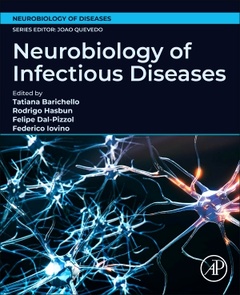Neurobiology of Infectious Diseases Neurobiology of Disease Series
Coordonnateurs : Barichello Tatiana, Dal-Pizzol Felipe, Hasbun Rodrigo

Neurobiology of Infectious Diseases covers mechanisms underlying infectious diseases. It is divided into six distinct sections, beginning with the foundations of Neuroinfection. This section includes chapters on the role microbiota-gut-brain axis and specialized blood-neuronal barriers play in neurobiology of infectious diseases. The next three sections detail various bacterial infections, parasitic infections, viral infections, and fungal infections of the central nervous system. The last section reviews the proteins and other peripheral mediators that affect the central nervous system. Internationally contributed by experts in the field this book sets the foundation of neurobiology and infectious disease. Neurobiology is the study of cells of the nervous system and the organization of these cells into functional circuits that process information and mediate behavior. Current research is vital for determining pharmaceutical and medicinal treatments for neurological disorders, psychiatric disorders and diseases.
Table of Contents (revised after reviewer’s comments and AE’s recommendations): Part I - Foundations of Neuroinfection 1. Anatomical organization of CNS 2. The enteric nervous system's (ENS) impact on the neurobiology of infectious diseases 3. The role of the microbiota-gut-brain axis on the neurobiology of infectious diseases 4. The role and function of specialized blood-neuronal barriers: blood-CSF, blood-retinal, blood-spinal cord, blood-labyrinth, blood-nerve, and BBB barriers. 5. The glymphatic system: What is it, and its function on the neurobiology of infectious diseases? 6. Neuro-immune interactions in health and disease 7. The routes and mechanisms of microbial translocation to the CNS Part II - Bacterial Infections Of CNS 8. Brain infections, encephalitis, and meningitis: Streptococcus pneumoniae 9. Brain infections, encephalitis, and meningitis: Neisseria meningitidis 10. Brain infections, encephalitis, and meningitis: Mycobacterium tuberculosis 11. Brain infections, encephalitis, and meningitis: Neurosyphilis 12. Brain infections, encephalitis, and meningitis: Lyme disease - Lyme Borreliosis 13. Brain infections, encephalitis, and meningitis: Brucelosis 14. Brain infections, encephalitis, and meningitis: Listeria monocytogenesis - Listeriosis 15. Sepsis-associated-encephalopathy: understanding the brain dysfunction in sepsis. Part III - Parasitic Infections Of CNS 16. Human trypanosomiasis: Trypanosoma brucei, Trypanosoma cruzes 17. Cerebral Malaria: understanding the parasite pathogenesis in the brain. 18. Neurocysticercosis and other CNS helminthic infections 19. Free-Living Ameba: the protozoa, the pathogenesis, and the CNS disease. 20. Pathophysiological mechanisms of Toxoplasma gondii infection in the CNS 21. Neurologic manifestations of Leishmania spp. Part IV - Virus Infections Of CNS 22. HIV-infected human brain: implications in HIV infection and immune response. 23. SARS-CoV-2 and nervous system: From pathogenesis to clinical manifestation. 24. Epstein-Barr virus infections of the central nervous system (CNS) 25. Herpes Simplex Virus, Varicella-zoster: infection of the Central Nervous System (CNS). 26. Rhabdoviridae virus: infection of the Central Nervous System (CNS). 27. Paramyxoviridae: infection of the Central Nervous System (CNS). 28. Zika virus: infection of the Central Nervous System (CNS). 29. Yellow Fever: infection of the Central Nervous System (CNS). 30. Dengue Fever: infection of the Central Nervous System (CNS). 31. Japanese encephalitis virus (JEV): infection of the Central Nervous System (CNS). 32. West Nile viruses: infection of the Central Nervous System (CNS). 33. Tick-borne Encephalitis (TBE) 34. La Crosse encephalitis and Omsk hemorrhagic fever virus: infection of the Central Nervous System (CNS). 35. HTLVs: infection of the Central Nervous System (CNS). 36. Chikungunya virus (CHIKV): infection of the Central Nervous System (CNS). Part V– Fungal Infections Of CNS 37. Brain infections, encephalitis, and meningitis: Cryptococcus sp. 38. Brain infections, encephalitis, and meningitis: Histoplasma capsulatum 39. Brain infections, encephalitis, and meningitis: Hyphae - fungus 40. Brain infections, encephalitis, and meningitis: Coccidioides sp. 41. Brain infections, encephalitis, and meningitis: Candida sp. Part VI – Proteins And Other Peripheral Mediators That Affect The CNS 42. CNS and Prions disease: a-synuclein, amyloid-ß, and others. 43. Creutzfeldt-Jakob disease (CJD), Variant CJD, and Kuru Variably protease-sensitive prionopathy (VPSPr) 44. Antineutrophil cytoplasmic antibody (ANCA), Sydenham chorea, PANDAS, and PANDAS variants.
Dr. Felipe Dal-Pizzol’s research efforts are focused on translational research in sepsis, mainly on the mechanisms of brain dysfunction, oxidative stress, and mitochondrial dysfunction. He has ongoing collaborative studies in other research areas such as the biology of psychiatric disease. I have authored more than 320 peer-reviewed publications and specifically, in the sepsis field more than 100 peer-reviewed publications. During the last years, He has been an associated editor of some peer-reviewed scientific journals such as PLoS One, Oxidative Medicine and Cellular Longevity, Brazilian Journal of In
- Reviews the role and function of specialized Blood-Neuronal Barriers
- Covers various forms of brain infections, encephalitis, and meningitis
- Features content on SARS-Cov-2 and CNS, including pathogenesis to clinical manifestation
Date de parution : 11-2024
Ouvrage de 600 p.
19x23.3 cm



